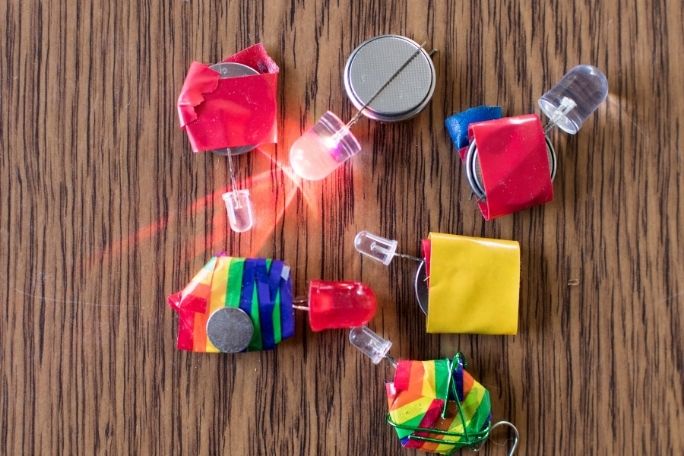Lesson summary
This is a STEAM lesson, which adds the Arts to STEM (Science, Technology, Engineering and Mathematics).
Tatsuo Miyajima is a Japanese contemporary artist who creates artworks using light and numbers. In this lesson, his work acts as a stimulus for student exploration of electrical circuits and prompts them to explore how light can be used as a form of artistic expression.
Learning intentions:
Students will...
- understand how art can be made using creative mediums
- understand how simple circuits work.
Success criteria:
Students can...
- create simple series and parallel circuits
- describe the movement of electricity through a simple series and parallel circuit
- use simple circuits to create a work of art using light.
Lesson guides and printables
Lesson details
Curriculum mapping
We encourage you to teach STEAM both through and between disciplines (transdisciplinary).
This lesson could be used across multiple strands of the curriculum, including Science and Maths. Consider focusing on a curriculum strand that will complement other areas of learning you and your students are working on.
Syllabus outcomes: ST3-6PW, VAS3.1, VAS3.2, ST3-6PW, ST3-7PW, MA3‑1WM, MA3‑2WM, MA3‑3WM, MA3-9MG, MA3-10MG, MA3-15MG, MA3-16MG, MA3-17MG
General capabilities: Critical and creative thinking, Literacy, Numeracy.
Cross Curriculum Priorities: Sustainability.
Unit of work: STEAM Made Simple – Primary
Time required: 120 mins
Level of teacher scaffolding: Medium – The level of teacher support required in this lesson will vary depending on the students’ scientific understanding and their ability to develop ideas in open-ended tasks.
Resources required
- Art of Light Design Brief (printed A3 or projected for the class to view)
- Art of Light Reflection Prompt (one per student)
- Device capable of presenting a video to the class
- Exploring Circuits Task Card (for students who complete the initial task)
- Light Art Design Sheet (one per student)
- Making Circuits Step by Step Instructions (one per two students or equipment to project to the class)
- One circuit board kit per student with light bulbs, wires, and a power source
- Tatsuo Miyajima Description Worksheet (one per student)
- Various items to be used in light-based artwork, such as cellophane, coloured paper, or markers
Skills
This lesson is designed to build students’ competencies in the following skills:
- Communication
- Community engagement
- Creativity
- Critical thinking
Additional info
STEAM Education:
Over recent years, the importance of STEM has been heavily promoted and discussed within fields of education. This has been within the context of ensuring that the next generation of students are provided with relevant knowledge and skills for the 21st century. STEM acknowledges the importance of the interrelated nature of science, technology, engineering and mathematics and the prominence of these skills in a world of continuous technological advancement.
What was missing from this original acronym, however, was an acknowledgement of the vital importance of artistic and creative thinking. The ability to think outside the box to develop artistic and creative solutions.
The relevance of art is integral to success in all of the original STEM areas, and so STEAM education is now moving to the forefront. Significant figures in science and technological advancement (notably Leonardo DaVinci, Albert Einstein and Steve Jobs) valued and applied the contribution of artistic skill into their work and art, design and creativity is also pivotal to success in industries such as marketing, advertising and promotion.
This is an original Cool+ lesson.


Welcome back!
Don't have an account yet?
Log in with:
Create your free Cool.org account.
Many of our resources are free, with an option to upgrade to Cool+ for premium content.
Already have an account?
Sign up with:
By signing up you accept Cool.org's Terms and Conditions(Opens in new tab) and Privacy Policy(Opens in new tab).